幻方算法(Magic Square)学习笔记
来源:互联网 发布:msf漏洞渗通135端口 编辑:程序博客网 时间:2024/06/05 01:54
一、幻方按照阶数可分成了三类,即奇数阶幻方、双偶阶幻方、单偶阶幻方。
二、奇数阶幻方(劳伯法)
奇数阶幻方最经典的填法是罗伯法。填写的方法是:
把1(或最小的数)放在第一行正中;按以下规律排列剩下的(n×n-1)个数:
(1)每一个数放在前一个数的右上一格;
(2)如果这个数所要放的格已经超出了顶行那么就把它放在底行,仍然要放在右一列;
(3)如果这个数所要放的格已经超出了最右列那么就把它放在最左列,仍然要放在上一行;
(4)如果这个数所要放的格已经超出了顶行且超出了最右列,那么就把它放在底行且最左列;
(5)如果这个数所要放的格已经有数填入,那么就把它放在前一个数的下一行同一列的格内。
例,用该填法获得的5阶幻方:
17
24
1
8
15
23
5
7
14
16
4
6
13
20
22
10
12
19
21
3
11
18
25
2
9
二、双偶数阶幻方(海尔法)
所谓双偶阶幻方就是当n可以被4整除时的偶阶幻方,即4K阶幻方。在说解法之前我们先说明一个“互补数”定义:就是在n阶幻方中,如果两个数的和等于幻方中最大的数与1的和(即n×n+1),我们称它们为一对互补数。如在三阶幻方中,每一对和为10的数,是一对互补数 ;在四阶幻方中,每一对和为17的数,是一对互补数。
双偶数阶幻方最经典的填法是海尔法。填写的方法是:
以8阶幻方为例:
(1)先把数字按顺序填。然后,按4×4把它分割成4块(如图)
1
2
3
4
5
6
7
8
9
10
11
12
13
14
15
16
17
18
19
20
21
22
23
24
25
26
27
28
29
30
31
32
33
34
35
36
37
38
39
40
41
42
43
44
45
46
47
48
49
50
51
52
53
54
55
56
57
58
59
60
61
62
63
64
(2)每个小方阵对角线上的数字(如左上角小方阵部分),换成和它互补的数。
64
2
3
61
60
6
7
57
9
55
54
12
13
51
50
16
17
47
46
20
21
43
42
24
40
26
27
37
36
30
31
33
32
34
35
29
28
38
39
25
41
23
22
44
45
19
18
48
49
15
14
52
53
11
10
56
8
58
59
5
4
62
63
1
三、单偶数阶幻方(斯特拉兹法)
所谓单偶阶幻方就是当n不可以被4整除时的偶阶幻方,即4K+2阶幻方。如(n=6,10,14……)的幻方。
单偶数阶幻方最经典的填法是斯特拉兹法。填写的方法是:
以10阶幻方为例。这时,k=2。
(1)把魔方阵分为A,B,C,D四个象限,这样每一个象限肯定是奇数阶。用罗伯法,依次在A象限,D象限,B象限,C象限按奇数阶幻方的填法填数。
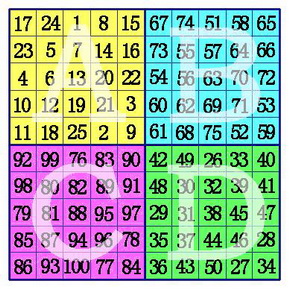
(2)在A象限的中间行、中间格开始,按自左向右的方向,标出k格。A象限的其它行则标出最左边的k格。将这些格,和C象限相对位置上的数互换位置。
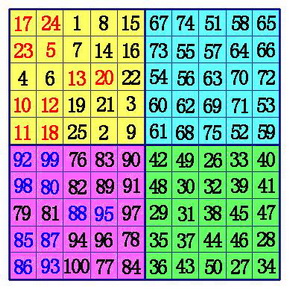
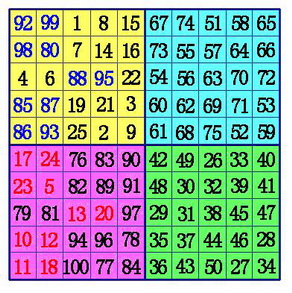
(3)在B象限所有行的中间格,自右向左,标出k-1格。(注:6阶幻方由于k-1=0,所以不用再作B、D象限的数据交换),将这些格,和D象限相对位置上的数互换位置。
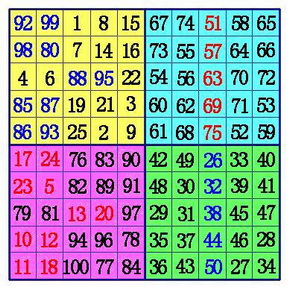
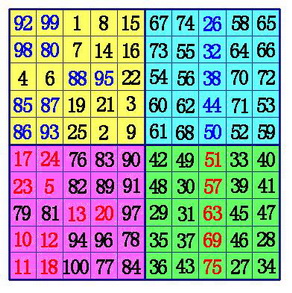
四、源代码如下,已加详细注释
- 幻方算法(Magic Square)学习笔记
- 幻方算法(Magic Square)
- XMU1016 Magic Square【幻方构造】
- ZOJ2835 Magic Square【幻方验证】
- 1302. Magic Square (奇数幻方,找规律)
- CodeForces-710C Magic Odd Square(幻方问题/构造)
- SicilyOJ(SOJ) 1302 Magic Square(Merzirac解奇幻方)
- 112 幻方 magic square M<set>运用集合的唯一性
- Codeforces Round #369 (Div. 2) B. Chris and Magic Square 数学、幻方
- JAVA "magic square"判定算法的实现。
- magic square
- magic square
- Magic Square
- magic squire幻方的学习——奇数阶幻方
- zoj 2835 Magic Square(水~)
- Sicily 1302 Magic Square (数论)
- 1318. Magic Square
- ZOJ 2835 Magic Square
- SourceInsight添加.S汇编语言
- windows 7下mysql5.5.18主从同步设置
- 测试屏小程序
- redhat RPM包相关命令
- 分享14个jQuery插件开发人员易犯的错误
- 幻方算法(Magic Square)学习笔记
- android酷炫翻页效果+图形分析
- 使用JS阻止按钮后台Click事件
- mysql忘记root密码如何重置
- 第十二周任务1
- css控制背景图片随div的大小而缩放
- 关于C++类的继承 的几个疑问
- Android 多Activity下的 menu 处理
- js操作iframe


